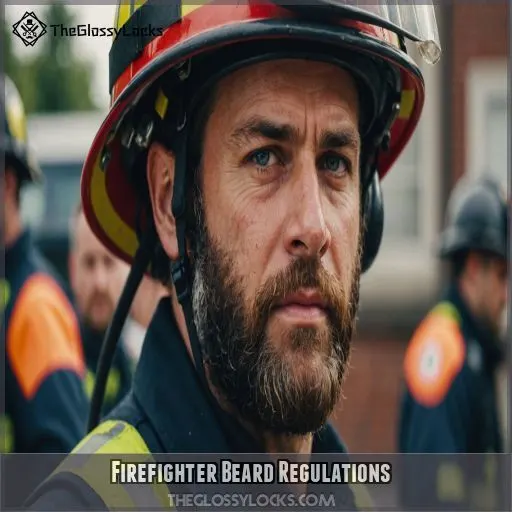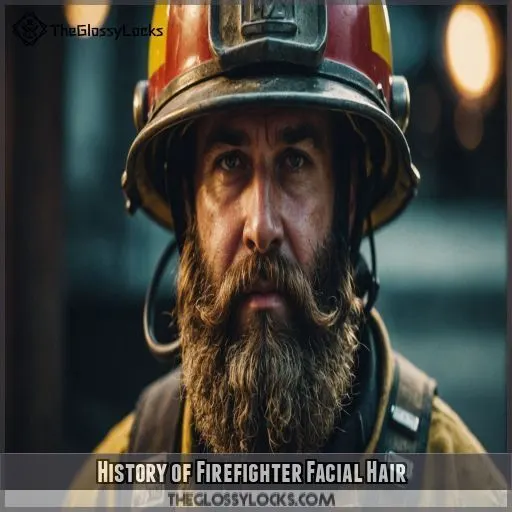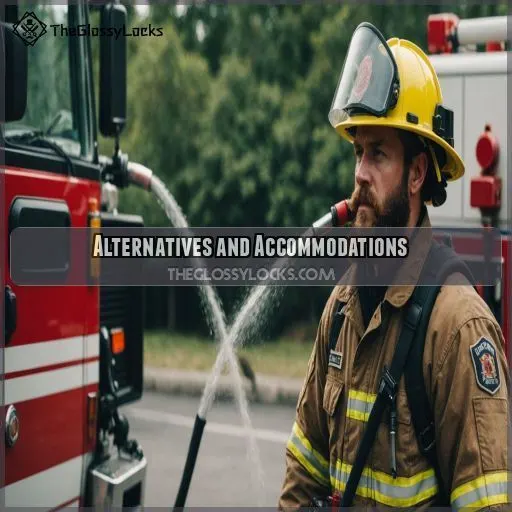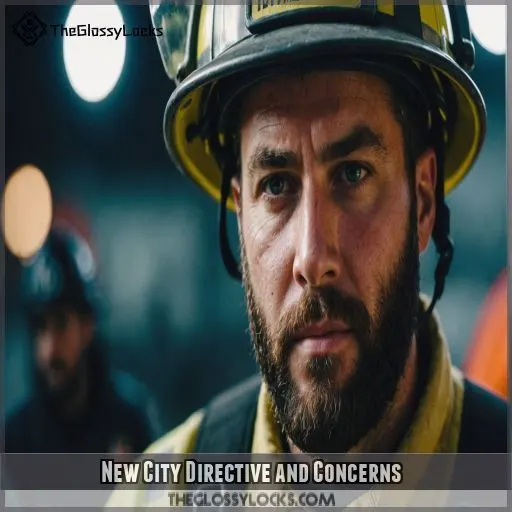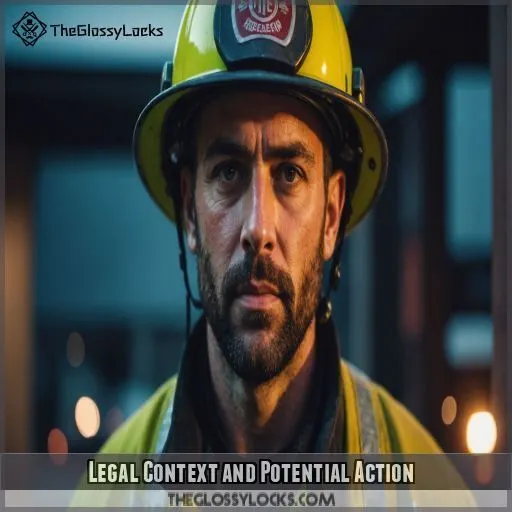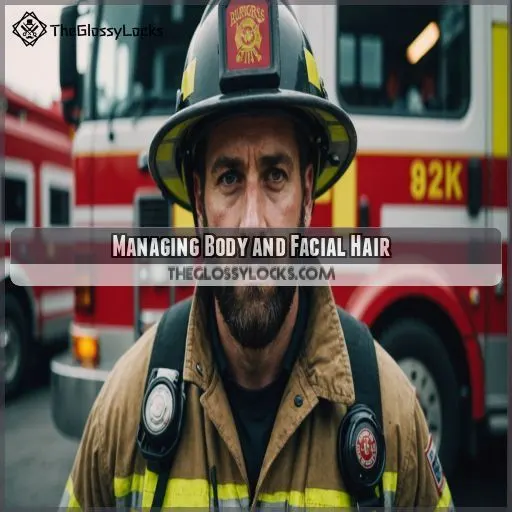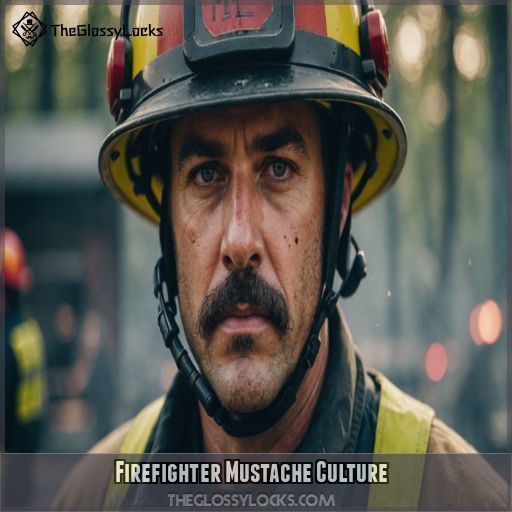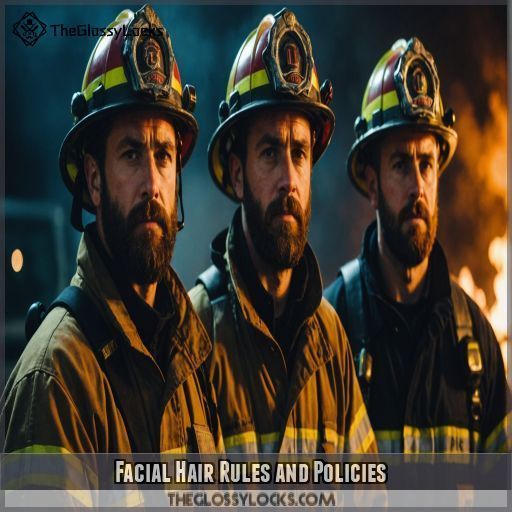This site is supported by our readers. We may earn a commission, at no cost to you, if you purchase through links.
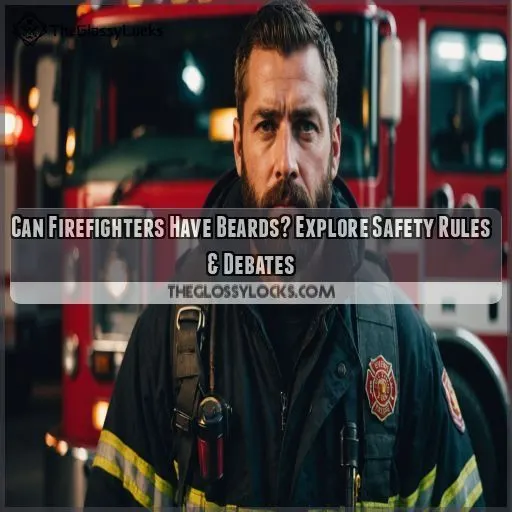 Wondering if firefighters can have beards? It’s a hairy situation!
Wondering if firefighters can have beards? It’s a hairy situation!
Safety regulations, like those from OSHA and NFPA, often prohibit beards because they can interfere with the seal of the important SCBA masks firefighters need.
So, imagine trying to keep soup in a bowl with a hole in it – that’s like a poor SCBA seal.
Departmental policies vary, though, and some might allow neatly kept facial hair.
However, the mustache proudly worn by many is a cultural symbol among firefighters.
Balancing identity and safety can be a tricky dance.
Curious about the possible exceptions and future of firefighter beards? Keep reading!
Table Of Contents
- Key Takeaways
- Firefighter Beard Regulations
- History of Firefighter Facial Hair
- Alternatives and Accommodations
- New City Directive and Concerns
- Legal Context and Potential Action
- Can Firefighters Have Beards?
- Managing Body and Facial Hair
- Firefighter Mustache Culture
- Facial Hair Rules and Policies
- Frequently Asked Questions (FAQs)
- Can you have facial hair as a firefighter?
- Why did firemen have beards?
- Are male firefighters allowed to have long hair?
- Can firemen have beards on Reddit?
- Can firefighters have long hair men?
- Can paramedics have beards?
- Can firefighters wear makeup?
- Can an introvert be a firefighter?
- Can firefighters have PTSD?
- Conclusion
Key Takeaways
- If you’re thinking facial hair might add to your rugged charm as a firefighter, hold your horses! Safety standards are strict about no beards, as they interfere with SCBA seals, making it cumbersome and risky, like trying to swim in boots.
- Some departments are considerate of personal expression and cultural or religious needs. They might allow a neatly trimmed mustache or even offer exemptions, kind of like getting a hall pass for facial fuzz, as long as safety isn’t compromised.
- The history of mustaches in firefighting is like an old family recipe – rich with tradition and camaraderie. Mustaches have stood the test of time, symbolizing unity and bravery, even if beards can’t join the party.
- While the no-beard rule might seem like a thorn in the side, there’s hope. New mask technology and accommodations might bridge the gap, allowing you to keep your facial identity without compromising safety.
Firefighter Beard Regulations
You might think firefighters could sport hefty beards like some hunky Hollywood heroes, but safety standards often say otherwise. Agencies weigh in on regulations, highlighting how facial hair might disrupt essential equipment, prompting a whisker-ly serious debate on safety versus style.
OSHA and NFPA Standards
You may be surprised to learn that OSHA and NFPA standards prohibit facial hair that interferes with respirator seals. This is a serious safety concern, as beards can prevent a tight SCBA mask fit, exposing firefighters to hazardous materials. While some departments allow limited facial hair, the bottom line is that safety is paramount regarding personal protective equipment.
Departmental Policies and Variations
Not all fire departments agree on beard policies. While some enforce strict clean-shaven rules for safety, others allow neatly kept facial hair, especially short mustaches. These variations often consider both public trust and personal expression. Departments may also provide exemptions for certain beard styles, acknowledging personal choice and cultural or religious needs.
Impact on Firefighting Equipment
Let’s face it, facial hair and firefighting equipment don’t always mix like the perfect recipe.
Beards can mess with your SCBA seal, making it hard to breathe safely.
They’re also not the best pals with helmet fit and visibility, leaving you exposed to breathing hazards.
In short, your beard might be charming, but equipment effectiveness demands a clean cut.
Safety Concerns and Risks
You’ve probably heard that a firefighter’s job is literally a battle against flames.
However, facial hair can act like a sneaky saboteur, causing SCBA seal failure, mask fit issues, helmet interference, and visibility reduction.
These aren’t mere annoyances; they’re breathing hazards that put you in harm’s way.
It’s like trying to fight a dragon while your armor falls apart.
Stay safe!
History of Firefighter Facial Hair
Firefighters have long sported iconic mustaches, but the debate over facial hair regulations has evolved over time. From clashing traditions to safety concerns, the history of firefighter facial hair is a complex tapestry woven with both personal expression and professional responsibilities.
Historical Origins of Mustaches
Mustaches have journeyed through time, proudly riding the upper lip! Their origins are intertwined with:
- Ancient civilizations where they were symbols of nobility.
- Military origins, marking bravery and valor.
- Cultural significance as expressions of identity like hair in ancient cultures
.
- Fashion trends, cycling through eras like bell-bottom jeans!
Much like a firefighter’s camaraderie, they’re more than facial hair—they’re badges of belonging.
Evolution of Facial Hair Policies
Mustaches have often been part of firefighter lore. Over time, regulations evolved due to changing attitudes and safety emphasis. Historical trends shifted from embracing bold whiskers to strict clean-shaven policies, focusing on SCBA safety. Legal challenges occasionally spark debate. Cultural impact remains, as many see facial hair as a timeless tradition clashing with modern safety needs.
Cultural and Symbolic Significance
From flamboyant handlebars to classic chevrons, facial hair in firefighting has deep roots in tradition. It’s about more than shaving—or not shaving. It’s a symbol of heritage and pride; part of identity and belonging.
- Symbolic representation: Mustaches often represent firefighter culture.
- Professional image: Balancing personal expression with a neat look.
- History says: Beards once marked bravado.
Clash Between Tradition and Safety
Firefighters have long embraced facial hair as a symbol of their brotherhood and personal style. But this tradition now clashes with modern safety concerns. Departments must balance honoring their history with ensuring firefighters can use critical equipment effectively. It’s a delicate dance, as both sides fight passionately for what they believe in.
Interference With SCBA Seals
When it comes to the age-old clash between tradition and safety, facial hair can be a real rascal. Beards and mustaches often play havoc with SCBA seals, leading to mask fit issues. This isn’t just a hairy problem, it affects lives! Watch for:
- SCBA seal failure
- Beard impact on safety
- Facial hair policy
- Safety regulations
Helmet and Face Shield Compatibility
Speaking of seal integrity, let’s not forget helmet and face shield compatibility. Imagine trying to squeeze a balloon into a small box—yep, that’s facial hair with protective gear. Beards can create visibility issues, like trying to drive through a foggy windshield. Maintaining head protection and ergonomics is important, so keep those whiskers in check for peak visibility.
Fire Hazards and Risks
Believe it or not, your beard could spark more interest than a campfire. Here’s why beards pose fire hazards for firefighters:
- SCBA Seal Integrity: A perfect seal’s important; beards break it.
- Heat Exposure: Beards catch heat like a hot potato.
- Visibility Issues: Smoke and mustaches make seeing hard.
- Equipment Malfunction: Facial fuzz trips your tools, not fantastic!
Impact on Firefighter Safety
Facial hair can seriously compromise your safety on the job.
That luscious beard may look great, but it can prevent your SCBA mask from sealing properly, exposing you to toxic fumes and hazardous materials.
And that unruly mustache? It could interfere with your helmet and face shield, limiting visibility when seconds count.
Stay clean-shaven to keep yourself and your crew safe.
Alternatives and Accommodations
If you’re wondering whether firefighters can sport beards, there are some alternatives and accommodations to think about. From specially designed masks to medical or religious exemptions, departments are exploring ways to let you keep your style without compromising safetybecause who says you can’t fight fire and keep your beard game strong?
Medical and Religious Exemptions
Worried about facial hair rules? Sometimes, the exemption process lends a hand. For religious freedom, a bit of paperwork and persistence might be your ticket. Got a medical condition? Whisper sweet nothings to your doctor for proper medical documentation. While case studies and legal challenges paint a tricky picture, hold your chin up—solutions are often just around the corner!
Specially Designed Masks
After considering medical and religious exemptions, let’s chat about specially designed masks. These innovative gems may help you maintain that stylish beard while keeping safety intact. Here’s what to think about:
- Mask Seal: Makes sure a snug fit.
- Design Challenges: Some masks cater to beard length.
- Fit Testing: Determine what suits your facial features best.
Think about your options and stay safe!
Departmental Solutions and Collaborations
Fire departments can work hand-in-hand with their firefighters to find creative solutions that balance safety protocols and cultural/religious needs. Some departments allow specific beard styles that meet their standards, while others may offer medical or religious exemptions on a case-by-case basis. With open communication and a collaborative spirit, common ground can often be found.
Exploring Options for Firefighters
Finding common ground in regulations is like fitting a square peg into a round hole! Firefighters face unique bewhiskered dilemmas, but don’t fret. Here are some options:
- Medical exemptions: If you’ve allergic reactions, you’re in luck!
- Religious accommodations: Discuss with your department for potential solutions.
- Mask technology: Consider using specially designed masks that accommodate facial hair.
New City Directive and Concerns
If you’re wondering whether firefighters can have beards, the city’s new directive might’ve you raising an eyebrow—or shaving it off. This rule requires all firefighters to be clean-shaven to guarantee safety, causing a hairy situation among those who cherish their beards.
Mandate for Clean-Shaven Firefighters
So, you’ve got your alternatives and accommodations sorted, right? Now, a new city directive says, "Clean-shaven or bust!" This raises eyebrows, especially for those valuing religious freedom or facing legal challenges. Some worry about impact on minorities and sick leave concerns. Departmental exemptions could help, but it’s a hair-raising situation with sparks flying!
Compliance and Non-Compliance
The city’s new clean-shaven directive leaves firefighters in a tight spot. You’ll need to comply by your next shift or face temporary limited duty. No more rocking that rugged mountain man look – it’s time to break out the razors, folks! But don’t worry, the department offers alternatives like sick leave if you can’t shave.
Impact on Firefighters With Waivers
You’re wondering how the new directive affects firefighters with waivers? Well, it’s a huge game-changer! These guys face legal implications and health concerns that are no small potatoes. Financial burdens could mount as sick leave options dwindle. Departments are scrambling, caught between balancing safety rules and respecting personal needs—a real juggling act! It’s a mustache-twirling situation!
Concerns and Reactions
Now folks are scratching their heads over the new directive. You might feel it’s a curveball, especially if you’ve got a waiver for pseudofolliculitis barbae. Here are the main concerns:
- Sick leave woes: Relying on it could mean financial hardship.
- Legal challenges: Possible EEOC grievances loom.
- Uncertain future: A directive clash with personal circumstances is like living in a soap opera.
Legal Context and Potential Action
You might think beards and firefighting go together like peanut butter and jelly, but Florida law and OSHA standards tell a different story. As firefighters in this heated debate, you’d better gear up for potential legal battles, grievances, and challenges over those favored facial follicles!
Florida Law and OSHA Standards
The city cites Florida law requiring OSHA standards for fire departments. This means no facial hair that interferes with SCBA seals. While the Brotherhood of Firefighters is disappointed, the city offers alternatives like light duty or sick leave. But the union plans to file grievances, arguing the policy unfairly targets certain firefighters.
State Fire Marshal’s Safety Rules
In exploring Florida law, you’ll find that the State Fire Marshal’s Safety Rules ban facial hair that messes with SCBA seal requirements. It’s like trying to fit a square peg in a round hole! These rules aim to protect public safety. Concerns include:
- Risk to proper respirator function
- Increased exposure to hazards
- Limited facial hair exemptions
Historical Cases and Rulings
If you’ve ever wondered about the legal tussles over firefighter beard policies, SCBA seal cases are at the heart of it. Legal precedents like EEOC rulings have sparked debates on religious exemptions and firefighter rights. While rulings vary, they’re often as tangled as your uncle’s fishing line, emphasizing safety over style. It’s about balancing regulations and personal expression.
Anticipated Grievances and Challenges
You’re bound to see some sparks fly if firefighters file grievances about this clean-shaven directive. They’re ready to kick up a fuss, possibly leading to an EEOC lawsuit. Legal precedents might favor religious exemptions, so the city’s response will be essential. Financial hardship looms, but historical rulings offer hope. Let’s see how this lawsuit goesgrab your popcorn!
Can Firefighters Have Beards?
Can firefighters have beards? It’s a complex issue with valid safety concerns, but also cultural traditions and personal preferences. As you’ll discover, the debate over firefighter facial hair regulations continues to evolve.
Unpacking the Debate
In firefighting, the beard debate isn’t just about style. It’s a tango between safety and culture. Sure, beards have character, but can they fit under safety regulations? As firefighters weigh the future of their facial fuzz, they juggle exemptions, cultural significance, and safety protocols. It’s a hairy situation—quite literally—worth contemplating!
Why Beards Aren’t Usually Allowed
Though rocking a beard might suit you, in firefighting, it can spell trouble. With safety concerns like SCBA seal interference and helmet fit issues, facial hair isn’t your best friend. Imagine a pesky squirrel on your face while handling life-saving equipment—it just doesn’t work. Prioritizing a professional image is key, ensuring you’re ready when duty calls.
Why Are So Many Firefighters Upset?
Beards can throw a wrench in the works for SCBA seals, but why’s everyone up in arms about this new rule? Besides safety, it’s about:
- The financial hardship and extra sick leave for those forced off duty.
- Legal action looming due to its impact on those with pseudofolliculitis barbae.
- The sudden uprooting of personal and cultural identity.
The Future of Firefighter Beards
As the debate over firefighter beards continues, the future remains uncertain. While some departments may loosen restrictions, safety concerns and legal challenges persist. However, innovative mask designs and collaborative policy changes could pave the way for more inclusive solutions. The path forward requires balancing tradition, diversity, and the paramount need to protect firefighters’ lives.
| Potential Outcomes | Likelihood | Impact |
|---|---|---|
| Legal Challenges Succeed | Moderate | High |
| Diversity-Focused Policy Changes | Moderate | Moderate |
| Technological Solutions Emerge | High | High |
| Public Opinion Shifts | Low | Moderate |
Managing Body and Facial Hair
For managing body and facial hair as a firefighter, you’re almost like a sculptor balancing precision and practicality. Don’t let tangled mustaches or wild beards throw a wrench in your fireproof ensemble; keep things tidy with some creative grooming hacks and your trusty razor, and youre good to go!
Precision Beard Grooming
How do you keep a beard in line with safety rules? Precision grooming can make all the difference:
- Beard Trimming Techniques: Keep it short and tidy to make sure a snug respirator fit.
- Beard Oil Benefits: Hydrate your facial hair and skin to prevent irritation beard oil benefits.
.
- Beard Care Routine: Regular maintenance ensures a neat appearance and safety compliance.
Trim smart, stay safe!
Waxing or Hair Removal Creams
Wondering about managing facial fuzz? Waxing or using hair removal creams could be your magic tricks. These methods help you tackle hair growth while keeping your skin irritation-free and smooth growing out short hair.
. Sure, waxing might sting a bit—like ripping off a Band-Aid—but it’s pain management worth the squeal! Plus, cream effectiveness offers alternative methods for easygoing gents.
Short and Tidy Hairstyles
Maintaining a short and tidy hairstyle is important for firefighters. Avoid long locks that could interfere with your helmet or SCBA mask. Opt for a clean, professional cut that keeps your hair out of your face. Some departments even have specific length regulations to make sure your safety and appearance on the job. With a little grooming, you’ll look sharp and ready to respond.
- Keep hair short and neatly trimmed
- Avoid styles that could obstruct vision
- Comply with departmental length policies
- Maintain a professional, well-groomed appearance
Routine Personal Hygiene Practices
Handwashing mightn’t be rocket science, but here it’s your shield. Showering after shifts washes off grime and stress. Keep dental care excellent; no one wants to smell yesterday’s lunch! Nail trimming keeps you firefight-ready (and scratch-free). Deodorant? That’s just friendship insurance; trust us, your crew will thank you. Maintain these daily and stay fresh!
| Practice | Why You Need It | Pro Tip |
|---|---|---|
| Handwashing | Germ defense | Sing a song while washing! |
| Showering | Refresh and revive | Use an invigorating scent |
| Dental Care | Winning smiles | Floss like a boss |
| Nail Trimming | Avoid snags | Keep a kit in your bag |
Firefighter Mustache Culture
Firefighter mustaches are more than just facial hair; they’re a badge of camaraderie and personal expression. From famous staches in firefighting history to "Movember" mustache-growing contests for charity, these hairy badges bring style and smiles to a serious job.
Symbol of Brotherhood and Camaraderie
In firefighter culture, mustaches are more than just facial hair—they’re symbols of camaraderie and team spirit. Imagine the warmth of brotherhood rituals, where shared experiences forge unbreakable bonds. Whether it’s a quirky nod to tradition or a comforting badge of unity, these iconic mustaches reinforce the unspoken understanding and trust that firefighters rely on in challenging moments.
Personal Expression and Style
As a firefighter, your facial hair can be a way to express your personal style and individuality.
Whether you rock a neatly trimmed mustache, a rugged beard, or a clean-shaven look, your grooming choices reflect your unique personality.
Just be mindful of safety regulations and make sure your facial hair doesn’t interfere with critical equipment.
After all, looking sharp on the job is important, but your safety comes first.
Famous Firefighters With Iconic Mustaches
Embracing your unique style? You’re not alone! Firefighters have sported iconic mustaches that symbolize more than just personal expression. Picture mustache styles like Tom Selleck’s or historical figures whose lip-hair left a cultural impact. Their modern influence extends beyond fashion, embodying the legacy of bravery within the firehouse walls: every whisker a symbol of courage and camaraderie.
Movember and Charitable Efforts
movember’s magic transforms firefighters’ faces into fundraising powerhouses! Join beard-growing challenges to boost fire safety awareness and charity partnerships. Your mustache becomes more than a fashion statement—it’s a community support badge, sparking smiles and solidarity. Ride the mustache wave with humor, helping those in need while keeping the fire-loving hairs safely at bay. Let that mustache do some good!
Facial Hair Rules and Policies
You might think growing a beard as a firefighter is a great way to enhance your rugged image, but it’s important to consider the safety rules.
.
But facial hair rules can get tricky, taking into account safety concerns and equipment compatibility.
Don’t worry, we’ll guide you through the maze of these policies and give you a peek into what the future might hold for firefighters wishing to embrace a bit more facial fuzz.
Safety Regulations and Concerns
The rules around firefighter facial hair are no-nonsense – OSHA and NFPA standards prohibit any facial hair that could interfere with your SCBA seal. While some departments allow short mustaches, beards are generally off-limits due to the serious fire hazards and safety risks. But don’t worry, there may be options like medical or religious exemptions if you qualify.
Impact on Firefighter Appearance
Safety concerns are one side of the coin, professionalism and public perception the other.
With strict facial hair rules, firefighters’ appearance leans toward uniformity, fostering trust and respect.
Imagine if the firehouse felt like Woodstock!
Keep those whiskers disciplined to make sure you’re embraced by the community as a trusty, reliable protector, not mistaken for an extra in a retro rock video.
Future of Facial Hair in Firefighting
Imagine a future where beard technology lets firefighters sport their facial hair without risking safety.
You might wonder about religious exemptions or legal challenges.
Rest assured, these issues are up for debate.
As cultural impact sways public perception, fire departments might embrace new solutions, making sure safety isn’t tossed out with the bathwater while everyone gets to express their style.
Frequently Asked Questions (FAQs)
Can you have facial hair as a firefighter?
Picture trying to seal a leaky balloon with a mustache in the way! Firefighters face strict rules—often no beards—due to safety. You might find compromise through exceptions or special masks, but it’s a hairy situation!
Why did firemen have beards?
Firemen used to have beards, often for warmth or style. But, under today’s regulations, facial hair is a no-go due to safety concerns with sealing SCBA masks, which makes beards a bit of a hot-button issue!
Are male firefighters allowed to have long hair?
You’ve got the hair, and we get it, it’s tempting to let it flow! But male firefighters should keep it manageable. Long hair’s typically fine if tied back securely, ensuring it doesn’t interfere with safety gear, but Ayurvedic Hair Care can help with healthy hair growth and overall hair health.
. Stay stylish, stay safe!
Can firemen have beards on Reddit?
Firefighters’ facial hair policies vary by department. While some allow short styles, others require a clean-shaven look for safety reasons. Check with your local fire department to understand their specific grooming requirements.
Can firefighters have long hair men?
Think of your hair as a wild stallion—it must be tamed for the saddle of safety! Firefighters can have long hair, but you better keep it secured so it doesn’t interfere with helmets or equipment.
Can paramedics have beards?
Paramedics can rock a beard, but it depends on company policies and any safety equipment requiring a tight seal. If your work doesn’t mind a bit of scruff, and safety’s still a go, then beard away!
Can firefighters wear makeup?
Imagine Sarah, a firefighter who looks like she’s ready for a magazine cover but sticks to practicality. Makeup’s allowed as long as it doesn’t interfere with gear. Keep it sweat-proof and drama-free to make sure safety comes first!
Can an introvert be a firefighter?
As an introvert, you can absolutely thrive as a firefighter! The camaraderie and teamwork will bring you out of your shell, and your keen observation skills will make you an asset on the job. Don’t let your personality hold you back – go for it!
Can firefighters have PTSD?
PTSD can sneak into a firefighter’s life like an unwelcome guest. You’re juggling life-saving duties with emotional scars, needing understanding and support. Remember, reaching out for help is strength, not weakness, in this close-knit community.
Conclusion
The debate over beards for firefighters is complex, much like a firefighter working through smoke-filled rooms.
It’s about balancing safety with personal and cultural identity.
While regulations lean toward the clean-shaven for safety, mustaches persist as a proud cultural symbol.
As fire departments and policymakers explore solutions, you’ll witness an evolving landscape.
Whether it’s a neatly groomed mustache or a trimmed beard, you’ll need to consider both tradition and the rules safely.

